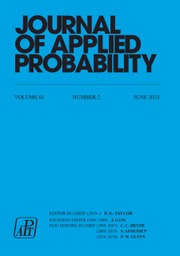Crossref Citations
This article has been cited by the following publications. This list is generated based on data provided by Crossref.
Grimmett, G.R.
1980.
A linear cell-size dependent branching process.
Stochastic Processes and their Applications,
Vol. 10,
Issue. 1,
p.
105.
Sudbury, Aidan
1981.
The expected population size in a cell-size-dependent branching process.
Journal of Applied Probability,
Vol. 18,
Issue. 01,
p.
65.
Caraco, T.
Barkan, C.
Beacham, J.L.
Brisbin, L.
Lima, S.
Mohan, A.
Newman, J.A.
Webb, W.
and
Withiam, M.L.
1989.
Dominance and social foraging: a laboratory study.
Animal Behaviour,
Vol. 38,
Issue. 1,
p.
41.
Metz, J.A.J.
Verboom, J.
and
Van den Bosch, F.
1989.
The average size of chain-like planktonic algal colonies.
Journal of Theoretical Biology,
Vol. 140,
Issue. 1,
p.
19.
Morgan, Byron J. T.
1993.
Expected size distributions in models of group dynamics.
Journal of Applied Probability,
Vol. 30,
Issue. 01,
p.
1.
Taib, Ziad
1997.
A multitype branching process model for blue-green algae.
Mathematical Biosciences,
Vol. 145,
Issue. 2,
p.
137.

